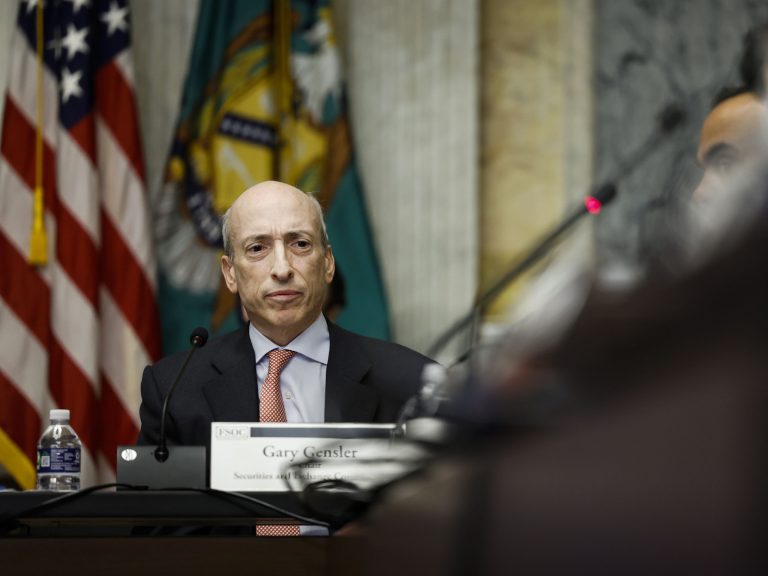
Grayscale, the largest digital asset manager in the world, has announced that it has requested a meeting with the U.S. Securities and Exchange Commission (SEC) to discuss the possibility of converting its flagship Grayscale Bitcoin Trust (GBTC) into a spot Bitcoin exchange-traded fund (ETF).
This move comes after the SEC approved several Bitcoin futures ETFs in October, which have attracted billions of dollars in inflows from investors seeking exposure to the cryptocurrency market. However, Grayscale argues that a spot Bitcoin ETF would be more beneficial for investors, as it would track the actual price of Bitcoin rather than the futures contracts, which often trade at a premium or discount to the spot price.
Grayscale also claims that a spot Bitcoin ETF would reduce the operational and regulatory risks associated with holding Bitcoin directly, as well as lower the fees and expenses for investors. Currently, GBTC charges a 2% annual management fee, while the Bitcoin futures ETFs charge between 0.65% and 1% per year.
Register for Tekedia Mini-MBA edition 17 (June 9 – Sept 6, 2025) today for early bird discounts. Do annual for access to Blucera.com.
Tekedia AI in Business Masterclass opens registrations.
Join Tekedia Capital Syndicate and co-invest in great global startups.
Register to become a better CEO or Director with Tekedia CEO & Director Program.
Futures-based bitcoin ETFs use contracts that promise to buy or sell bitcoin at a specified price and date in the future. They do not hold any actual bitcoin, but rather trade on derivatives markets that reflect the price movements of the underlying asset. Spot-based bitcoin ETFs, on the other hand, hold actual bitcoin in custody and track its market price directly.
One might expect that spot-based bitcoin ETFs would be more popular than futures-based ones, since they offer a more direct and accurate exposure to the cryptocurrency. However, in reality, futures-based bitcoin ETFs have been more successful in attracting investors and gaining regulatory approval.
There are several reasons why futures-based bitcoin ETFs are more popular than spot ones. Here are some of them:
Regulatory hurdles: Spot-based bitcoin ETFs face more challenges from regulators, who are concerned about the security, custody, and transparency of the underlying bitcoin. Futures-based bitcoin ETFs, however, do not have to deal with these issues, since they do not hold any actual bitcoin. They only have to comply with the rules and regulations of the derivatives markets, which are more established and familiar to regulators.
Cost efficiency: Futures-based bitcoin ETFs tend to have lower fees and expenses than spot-based ones, since they do not have to incur the costs of buying, storing, and securing bitcoin. They also avoid the risks of theft, loss, or hacking of the underlying bitcoin. Spot-based bitcoin ETFs, however, have to pay for these services and bear these risks, which can eat into their returns.
Liquidity and volatility: Futures-based bitcoin ETFs benefit from the high liquidity and low volatility of the derivatives markets, which allow them to trade more efficiently and smoothly. They also have access to leverage, which can amplify their returns or losses. Spot-based bitcoin ETFs, however, are subject to the liquidity and volatility of the actual bitcoin market, which can be more erratic and unpredictable. They also have no leverage, which limits their potential gains or losses.
Investor preference: Futures-based bitcoin ETFs appeal to a wider range of investors, who may not want to deal with the complexities and hassles of owning and managing actual bitcoin. They also cater to investors who want to speculate on the price movements of bitcoin without taking a long or short position on the cryptocurrency itself. Spot-based bitcoin ETFs, however, are more suitable for investors who want to own and hold actual bitcoin as a long-term investment or a hedge against inflation.
Grayscale’s CEO Michael Sonnenshein said in a statement: “We believe now is the time to convert GBTC into an ETF, and we are eager to make our case to the SEC for why they should approve our application. We have been working closely with our legal and regulatory advisors to prepare for this meeting, and we are confident that we can address any concerns or questions that the SEC may have.”
Grayscale’s meeting with the SEC is expected to take place in the coming weeks, but there is no guarantee that the regulator will approve its proposal. The SEC has been cautious about allowing spot Bitcoin ETFs, citing concerns about market manipulation, fraud, custody, and investor protection. The SEC’s chairman Gary Gensler has indicated that he prefers Bitcoin futures ETFs over spot ones, as they fall under the more stringent rules of the Commodity Futures Trading Commission (CFTC).
However, Grayscale is not giving up on its vision of creating a spot Bitcoin ETF, which it believes would be a game-changer for the crypto industry and its investors. Grayscale’s GBTC is currently the largest crypto fund in the world, with over $40 billion in assets under management. If it converts into a spot Bitcoin ETF, it will become the first and largest of its kind in the U.S., potentially attracting more institutional and retail investors to the crypto space.



